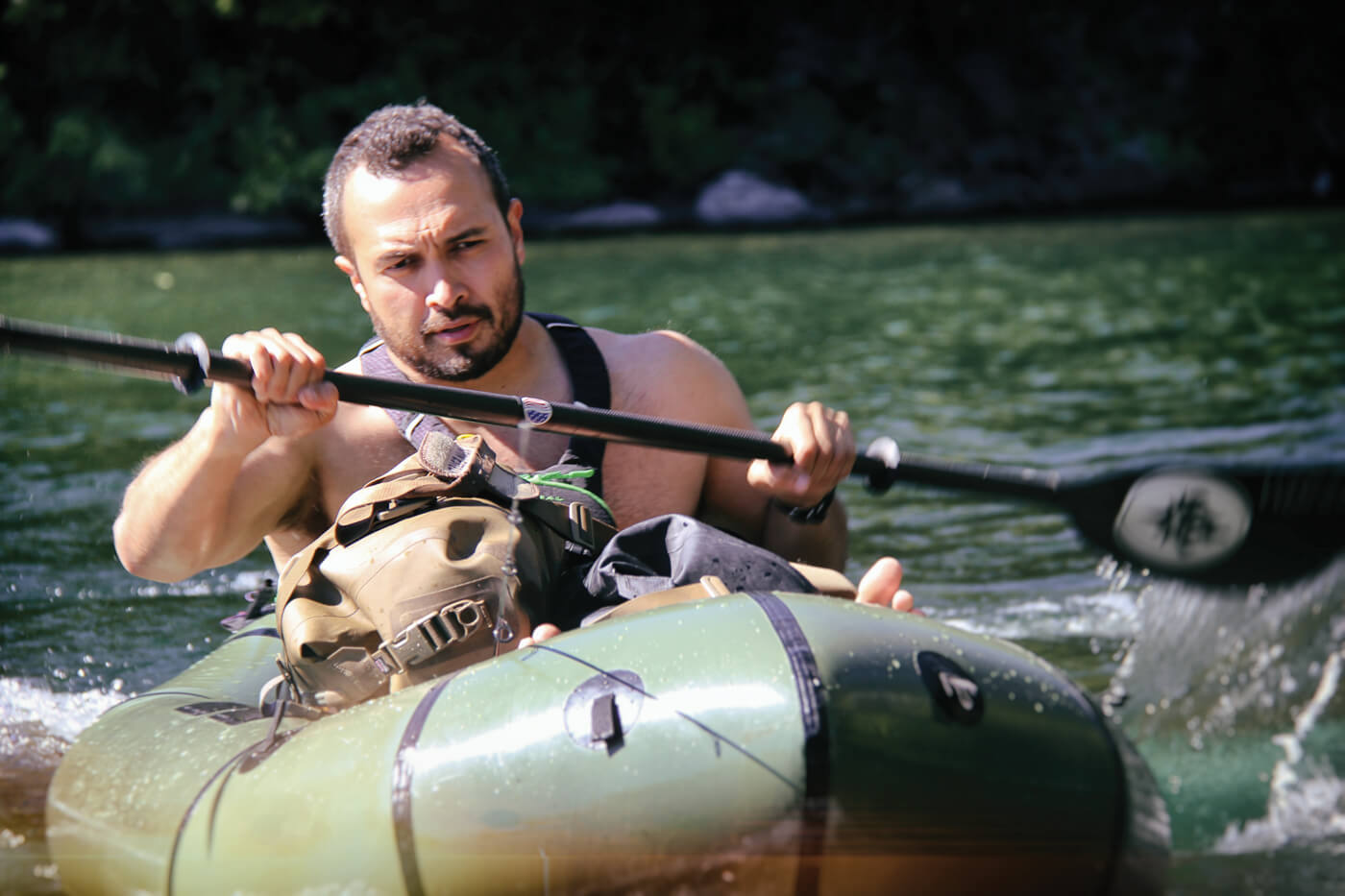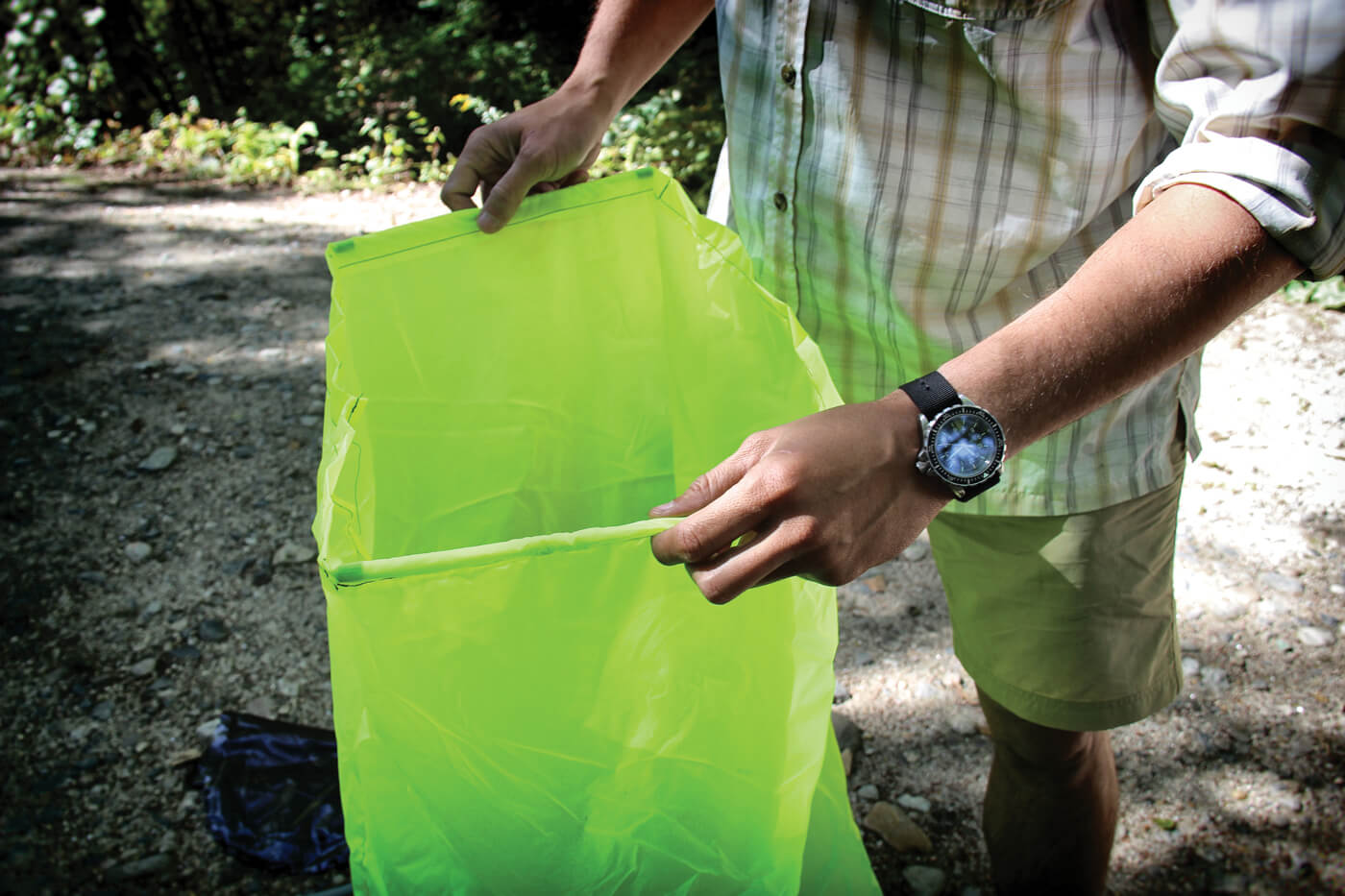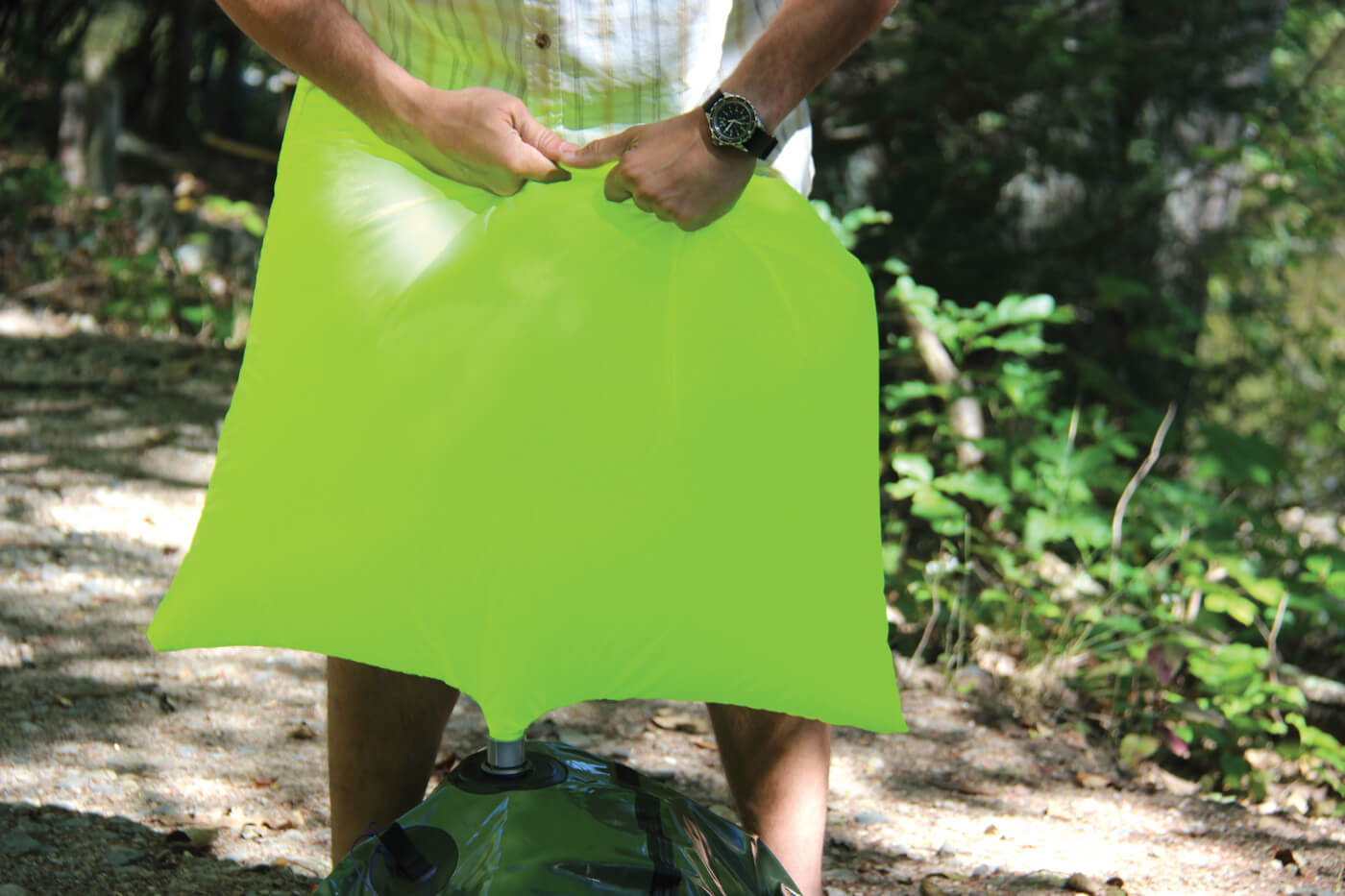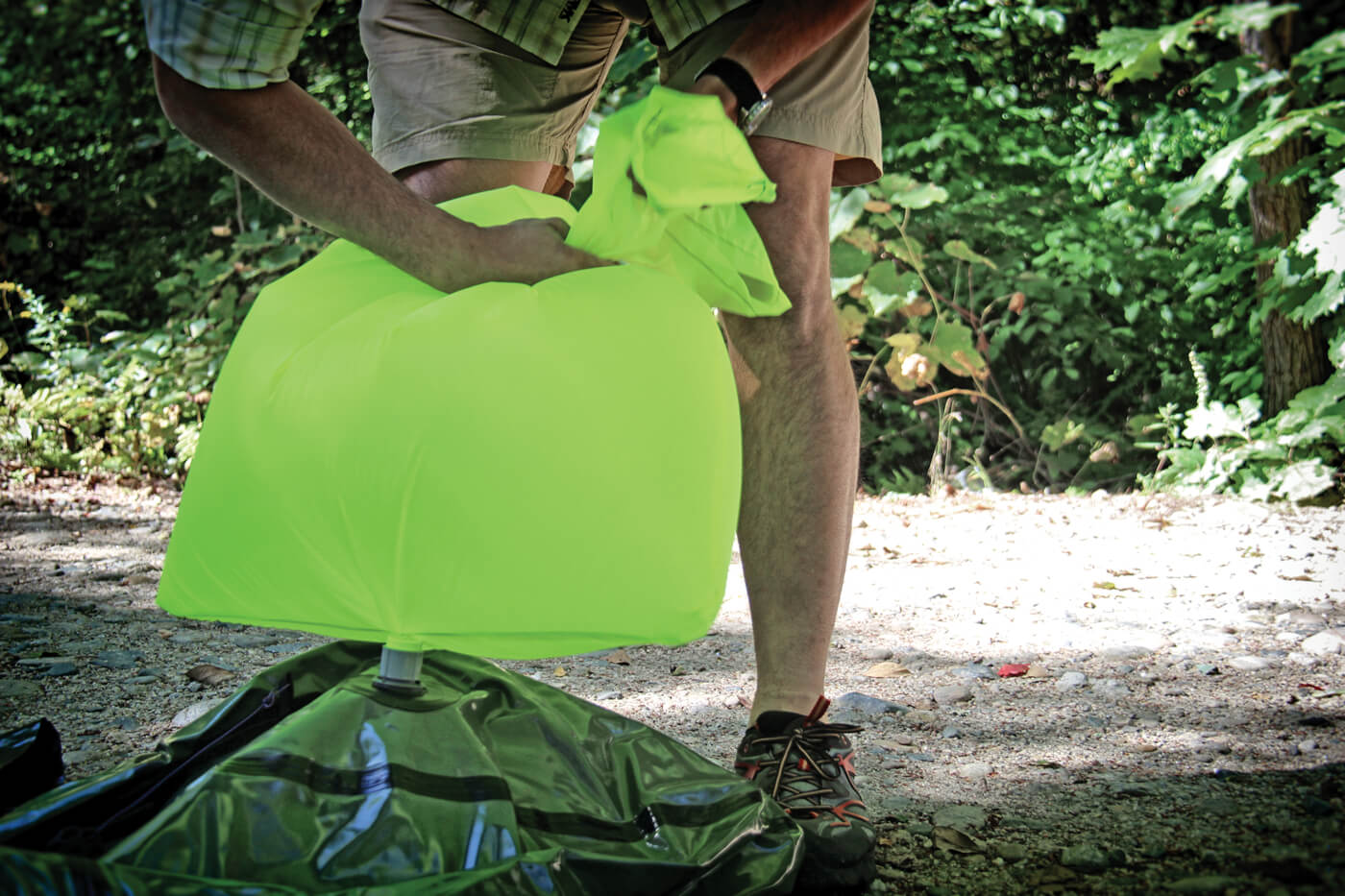The total combined weight of the Alpacka Raft Mule XL Inflatable Kayak, Astral Sea Wolf PFD and Werner Kalliste Paddle featured in this article is a mere 8.3 pounds. Let that sink in for a minute—the idea, not the watercraft. For perspective, 8.4 pounds is the average weight of a gallon of water. This featherweight water transportation is a perfect package for backpacking, a home in a flood zone or to throw in the suitcase for adventure travel. Alone, the Alpacka XL Kayak weighs only 5 pounds, 6 ounces and is an ideal addition to any loadout where water obstacles and travel are possibilities.
PURPOSE/NEED
Did you ever think, If I could just get out to where the fish are biting. How about, There’s no easy way around this lake. Water obstacles exist, and for those who travel into remote parts of the backcountry, it is likely travel will be impeded by a river, pond or lake. Backcountry travel far from emergency services can be dangerous; adding additional miles to a trip means more chances of sprained ankles, accidental falls or encounters with dangerous game.

inflatables act as sails in the wind.
Sometimes, the water route is the better route. Pack rafts are already in use in various circles. Look to the backcountry hunters in Alaska who regularly use pack rafts to access remote areas. When there is no road, an over-water, straight-line route is going to be faster than traveling the circumference of a lake.
“Comparing the Alpacka Raft to early generations of boats is relatively simple: the Alpacka Raft is a much more capable craft with better performance all around.”
Foreign travelers know the frustration of excessive luggage fees and the difficulty of taking large parcels in rental cars, let alone via public transportation. Explorers and scientists have hauled pack rafts to remote bodies of water to inflate and use to reach their ultimate destination. National Geographic Channel’s Ultimate Survival Alaska featured them prominently, because teams raced down rivers with them.
The survival-savvy person can learn from the experience of others and add an Alpacka Raft to their fleet. It can be called into use during a flood, fishing trip or survival field exercise.
CONSTRUCTION/DESIGN
Alpacka Rafts are inflatables and therefore have some vulnerability to abuse. Even the most durable steel-belted radial tires are prone to deflating if compromised. That is the nature of the beast. Nevertheless, the company stands by its products and provides a three-year warranty on its boats. The materials Alpacka uses have been specially designed over 15 years—specifically for pack rafts—and a large majority of those produced over the years are still in use. Alpacka Rafts are inflatable, but they have survived Brooks Range trips and many expeditions during which other boats have failed. The boats are available in many configurations and sizes, thus ensuring the right fit for the circumstances.

While getting started, a question that came up among my close circle of instructor cadre and former students was, “How do you inflate that thing?” It’s a logical and practical question, because one would assume it must be more time-consuming and exhaustive than a simple inflatable camping mattress. The folks at Alpacka Raft include a unique pump that captures air and seals it in a bellows with a roll-down flap. It is squeezed much like a bagpipe to inflate the raft with more volume than human lungs can expel with even the deepest breath.
Lightweight in design, this pump is easily packed along with the raft when much easier inflation methods, such as a portable air compressor, aren’t available. If the survivor were to lose this included pump, the Alpacka Raft is equipped with twist-open/close valves that can be blown into. During testing, I inflated the raft at different times by using the provided pump, the mouth valve and an air compressor. The fastest inflation was with the air compressor, followed by the pump and then manually. Depending on the scenario, the speed of inflating the raft might be a factor and worthy of consideration.
The large valve for the pump makes deflation very quick and convenient.
DURABILITY
Inflatable kayaks are not as durable as traditional polyethylene boats, and durability is not the main selling point of any inflatable. However, this is not to say that inflatables are fragile and can’t be used as designed. During the moving-water phase of testing, there were many times when the boat was paddled over sluices where water barely covered the rocks underneath. Normal use did not affect the hull of the boat beyond reasonable scratching. To prolong the life of the boat during testing, I made sure to avoid excessive beaching.
In traditional watercraft, the temptation is always there to run the bow up onto the riverbank or shoreline. Because the bow sits low in the water in canoes and comes to a point, it’s an easy way to wear through a hull. With the Alpacka Raft, I could position my boat parallel to the shore, swing my legs over the side and step out. The full length of the hull held my weight against the river bottom, and this posed the least risk to the inflatable tube. Also, while fishing with the Alpacka Raft, I monitored the location of my treble-hooked lures and made sure I knew where all the sharps were located in my boat to avoid that accidental hook stuck through the hull.
“Alone the Alpacka XL Kayak weighs only 5 pounds, 6 ounces and is an ideal addition to any loadout where water obstacles and travel are a possibility.”
PERFORMANCE
Moving water: My background in paddling has roots in whitewater kayaking. In the past, inflatable kayaks functioned more like floating bathtubs and barges that were easily overtaken by the wind and performed more like a raft than a hard-sided kayak. Comparing the Alpacka Raft to early generations of boats is relatively simple: The Alpacka Raft is a much more capable craft with better performance all around. To test it out, I took it to the west branch of the Farmington River in Connecticut. Even with low water and more-exposed rocks (a great test of the durability of the craft), there was still plenty of moving water.

I used the Alpacka Raft as a traditional river-running kayak. This inflatable is not a modern play boat, and its limitations must be understood. It is very stable, and traditional kayak maneuvers incorporating turning the boat “on edge” to turn into and peel out of eddy lines feel different, because the tubes keep the boat upright and near parallel to the water’s surface. In faster-moving whitewater, the chance of swamping a traditional kayak is very real, but with the self-bailing floor more commonly found on whitewater rafts, the Alpacka Raft is in a unique class of its own. While the ride is wetter, there is no chance of swamping. Testing the boat in moving water was fun, to say the least.
“The Alpacka Raft is a real pleasure to paddle and capable of handling most reasonable waters.”

as this model from Slime, makes inflating the Alpacka Raft very quick.
The boat is very “loose.” That is, it spins readily upon the command of the paddle. While I tried to frame this review of the boat around the concept of river-running in remote areas, I reminded myself of the reality of river travel. In an emergency, scouting ahead limits the amount of rapids encountered. In less dire circumstances, the Alpacka Raft will keep you safe, because it is very forgiving in rough water.

A personal flotation device (PFD) is primarily meant to provide flotation, but that doesn’t mean it can’t be used as survival kit. If you are left literally “up a creek without a paddle,” you will at least have your life jacket on—that is, if you had the common sense to wear it and not stash it under deck webbing or inside your boat.
Before you jam all manner of equipment into your PFD’s pockets and lash gear to the compression straps, consider the reality of your situation and what gear will really be necessary for your safety and survival.
Knife. A quality knife, such as the Enuff Salt from Spyderco, is an absolute must. The Enuff Salt is ideal for a PFD, because it is rust resistant, has a sharp serrated blade and a brightly colored, textured handle. A PFD knife won’t be used every day, but it will be a necessity in an emergency. A good river knife can be used to literally cut boats in half or sever wrapped throw lines and webbing. Protect your knife’s edge, carry it securely, and inspect it prior to each river trip.
Fire starter. Hypothermia is a serious consideration after being immersed in frigid water. A good ferro rod with tinder should always be carried. Ferro rods will be impervious to all fresh water, but salt water will eat away at them. Carry your ferro rod contained in a watertight capsule, such as those from Exo-Tac.
Whistle and mirror. If you are separated from your boat, you are going to be without a large object easily spotted by rescuers. A whistle can be used to alert ground crews, and a mirror can be used for aircraft that might fly over areas not accessible by foot. For example, the UST Jet-Scream Whistle is flat and stores nicely on top of a mirror that will slip into a slot pocket.
Duct tape. No boater should be without duct tape—it can repair boats, be used as a bandage on top of gauze and will serve as an emergency fire starter. A length of it can be wrapped out of the way around PFD webbing.
Ditty kit/tube. A simple Nalgene bottle or floating keychain can hold all the other “ditty” items you might want: Steri strips, extra cash, fishing kits, purification tablets, button compass, etc. Keep these items small and easily packable. Regularly inspect your kit to make sure it is still water resistant and that the contents haven’t expired. A PFD provides buoyancy, but with more weight, it will be more challenged to keep you and your equipment afloat. In other words: Don’t carry too much and turn a life-saving device into an anchor to weigh you down. But however you decide to carry your gear is ultimately your choice. Make it a wise one.
Simply put: This boat belongs in moving water. Touring/packing: Out on the open water, I wanted to test how well the boat would work in windy conditions. I packed the boat with a reasonable amount of gear contained in my Watershed Dry bags. Because the boat sits lower in the water than inferior designs from yesteryear, it isn’t as affected by crosswinds… with a slight trade-off: With the added ballast of day-tripping gear up front, the boat tracked well and stayed true to course. However, it did require some extra effort to keep it moving at a considerable pace.

It wasn’t hunting season when I did this review, so I used the excess baggage to stand in as added weight that can be expected on a successful hunt. My 11-year-old niece also served as a test subject to see how a much lighter paddler would handle a larger boat. She had no trouble keeping the boat on course and maneuvering it in open water.

Spyderedge rips through webbing easily.
With more weight up front in the boat, the Alpacka Raft drafted (rode in the water) slightly deeper. As a result, open-water whitecaps splashed and cast some spray on top of the bow of the boat. For those concerned with exposing their gear to water, Alpacka Raft offers a spray skirt. Of course, the combination of water-resistant bags and the self-bailing floor means excess water will pour off your bags and drain through the floor.
Traditionally, at the end of a long paddle, the idea of shouldering your canoe or kayak is dreaded, so lifting a 5-pound boat out of the water is a welcome relief. Being able to “pop the cork” on it, roll it up and pack it out on a bicycle (if need be) is a far cry from having to lift a rigid boat up onto a roof rack.


FINAL THOUGHTS
As configured, the Alpacka Mule is an excellent boat for the survivalist, fisherman or outdoorsman in warmer weather. Due to the self-bailing floor, those who paddle this in colder water will notice the wet nature of the boat. However, for those who elect to wear waders and those using this boat in warmer weather, the trade-off of not having to bail the boat is worth it.
“Consider carrying your emergency gear in a pocket that’s easily removed in the water, has its own buoyancy and can be held in your hand.”
The only aspects of the boat’s design I would want changed are the single air chamber that runs throughout the craft and the “rapid-inflate system” that uses C02. For safety, a dual chamber could likely be added at the expense of a few ounces of weight for extra material, valves, etc.
Purchase a good paddle: The connection between the paddler and the water is the paddle. Far too many aspiring paddlers spend a considerable amount of money on their boats, only to skimp when it comes to this important item. Your paddle should be comfortable, and this starts with its weight. In general, the less a paddle weighs, the more you will pay. It should be the right shape, too. Touring paddles are more feathered, while whitewater paddles are broader. Purchase a good paddle and protect it. The right paddle makes all the difference.
Balance your boat (with gear and with yourself): Trimming your boat means balancing it. Make sure you have your gear packed so the weight is distributed evenly over the hull. This will result in the boat floating as horizontally as possible against the waterline. Too much weight forward, and the boat will plow through the water. Too much weight in the rear, and the bow will rise out of the water. In addition, too much weight to either side (port or starboard), and the boat will feel as if it might capsize.
Learn self-rescue techniques: Self-rescue means self-reliance. There is no telling when you will capsize or be forced to swim to safety. Self-rescue in an inflatable means learning how to right your boat, re-enter in deep water, and drain the water and reestablish yourself to begin paddling again. All self-rescue techniques should be practiced regularly in a controlled environment. It is not enough to be successful just once in a controlled setting. One must be able to repeat self-rescue techniques time after time to truly “own” the skill.
Know how to repair your boat: Whether your boat is inflatable or hard-sided, repair can mean the difference between a trip ending early or being successful. A boater should carry a good repair kit and also know how to patch their boat with it. Inflatable repair generally requires cleaning the surface, roughing it up with sandpaper, cutting the patch to size and epoxying it to the tear. These repairs can be practiced on scrap vinyl. When in doubt, quality duct tape will work as a temporary patch.
The rapid-inflate system would make this inflatable a great option for those operating small motorized boats who want an emergency raft they can paddle like a kayak and deploy quickly. Overall, the Alpacka Raft is a real pleasure to paddle and capable of handling most reasonable waters. It is an excellent option for the outdoorsman and is designed to help you unlock the backcountry.
(largest of four sizes)
Specifications
• Boater: Fits 6 feet, 2 inches to 6 feet, 8 inches
• Exterior dimensions: 92×7 inches
• Cockpit dimensions: 55×14.5 inches
• Base weight: 5 pounds, 6 ounces
• Packed size: 8×24 inches
MSRP: $895
CONTACT INFORMATION
(0970) 533-7119
Editor’s note: A version of this article first appeared in the January 2017 print issue of American Survival Guide.





